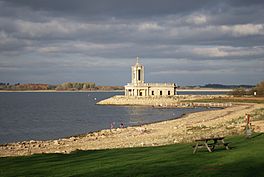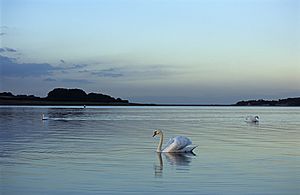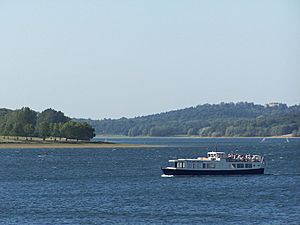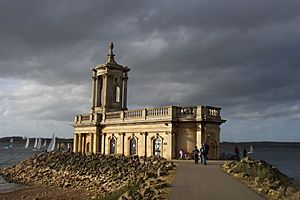Rutland Water facts for kids
Quick facts for kids Rutland Water |
|
|---|---|
 |
|
| Location | Rutland |
| Coordinates | 52°40′N 0°40′W / 52.667°N 0.667°W |
| Lake type | reservoir |
| Basin countries | England |
| Managing agency | Anglian Water |
| Designation | Site of Special Scientific Interest |
| Built | 1971–1975 |
| First flooded | 1976 |
| Surface area | 10.86 square kilometres (4.19 sq mi) |
| Water volume | 124 million cubic metres (4.4×109 cu ft) |
| Designated: | 14 October 1991 |
| Reference #: | 533 |

Rutland Water is a large reservoir (a man-made lake) in Rutland, England. It is located east of Oakham, the county town. This huge lake gets its water from the River Nene and River Welland. It helps provide drinking water to many homes in the East Midlands region.
Rutland Water is one of the biggest man-made lakes in Europe. By its surface area, it is the largest reservoir in England. However, Kielder Water can hold more water in total.
The reservoir is surrounded by about 3,100 acres (13 km2) of countryside. There is a 23-mile (37 km) path around the lake. This path is great for walking or cycling. Because water levels can change, some areas are kept wet. This helps protect the important wetland nature reserve areas.
A large part of the lake and its shore, about 1,555 hectares, is a special protected area. It is known as a Site of Special Scientific Interest. It is also a Special Protection Area for birds under European rules. A section of 1,333 hectares is a Ramsar site, which means it is an internationally important wetland. The Leicestershire and Rutland Wildlife Trust manages 393 hectares at the western end.
Contents
Building Rutland Water
Rutland Water was built by creating a dam across the River Gwash valley. This happened near a village called Empingham. The construction finished in 1975. While it was being built, people called it the Empingham Reservoir.
The project flooded about six or seven square kilometers of the Gwash valley. It also flooded a smaller valley near Oakham. Two villages, Nether Hambleton and most of Middle Hambleton, were removed. Their wells were sealed before the area was flooded. The nearby village of Upper Hambleton survived. It now sits on a long piece of land called the Hambleton Peninsula.
Most of the water stored in Rutland Water comes from the River Welland and the River Nene. These rivers are important sources of water for cities like Peterborough. The dam itself is made of clay. It is 115 feet (35 m) high and about 1,300 yards (1,200 m) long. The dam was designed to blend in with the natural landscape.
Rutland Water also has a special tower called a limnological tower. Scientists use this tower to study the lake's water and its living things.
Local Communities
The village of Upper Hambleton and the remaining parts of Middle Hambleton are now simply called Hambleton. They are located on a long peninsula that stretches into the middle of the lake. This land used to be a ridge between two valleys.
The few houses in Normanton were not flooded. However, its church was partly underwater. The lower part of the church building was made strong to protect it from water. The upper part was then used to tell visitors the story of how the reservoir was built. Some old grave markers from the church can now be seen at Edenham church in Lincolnshire.
Fun Activities at the Lake
Rutland Water is not just for storing water. It is also a very popular place for sports and outdoor activities.
- You can enjoy sailing and other water sports.
- Many people come here for fishing.
- There is a 25 miles (40 km) path around the lake for walking and cycling.
- A special boat called the Rutland Belle takes visitors on tours around the lake.
- Birdwatching is also very popular, attracting people from all over.
- The former butterfly center at Sykes Lane is now Bugtopia – The Zoo.
Amazing Wildlife
Large areas of wetland at the western end of the lake are a nature reserve. This reserve is managed by the Leicestershire and Rutland Wildlife Trust. It is a very important place for birds, especially in winter.
- Many gadwall ducks spend their winters here.
- You can also see shoveller ducks.
- The Anglian Water Bird Watching Centre is located here.
- Every August, the centre hosts the British Birdwatching Fair.
Other birds you might spot include:
- Lapwing
- Coot
- Goldeneye
- tufted duck
- Pochard
- Teal
- Wigeon
- Cormorant
- Great crested grebe
- little grebe
- Most notably, osprey were brought back to the area in 1996. One famous osprey was even named "Mr Rutland".
The lake is stocked with brown trout and rainbow trout for fishing. It also has many other types of fish that came from the River Welland and River Nene. These include:
Visitor Centres
There are two main visitor centres at Rutland Water:
Anglian Water Birdwatching Centre
This centre is in Egleton. It has a gift shop run by the Leicestershire and Rutland Wildlife Trust. There is also a shop where you can buy binoculars and telescopes. The centre includes the Rutland Environmental Education Centre. It has exhibits and windows that look out over the wetlands, perfect for birdwatching.
Lyndon Visitor Centre
The Lyndon Visitor Centre is on the south shore of the reserve. Here, you can find exhibits and windows for bird viewing. There are also trails and special hides (hidden spots) for watching birds without disturbing them.
See also
In Spanish: Embalse de Rutland para niños




